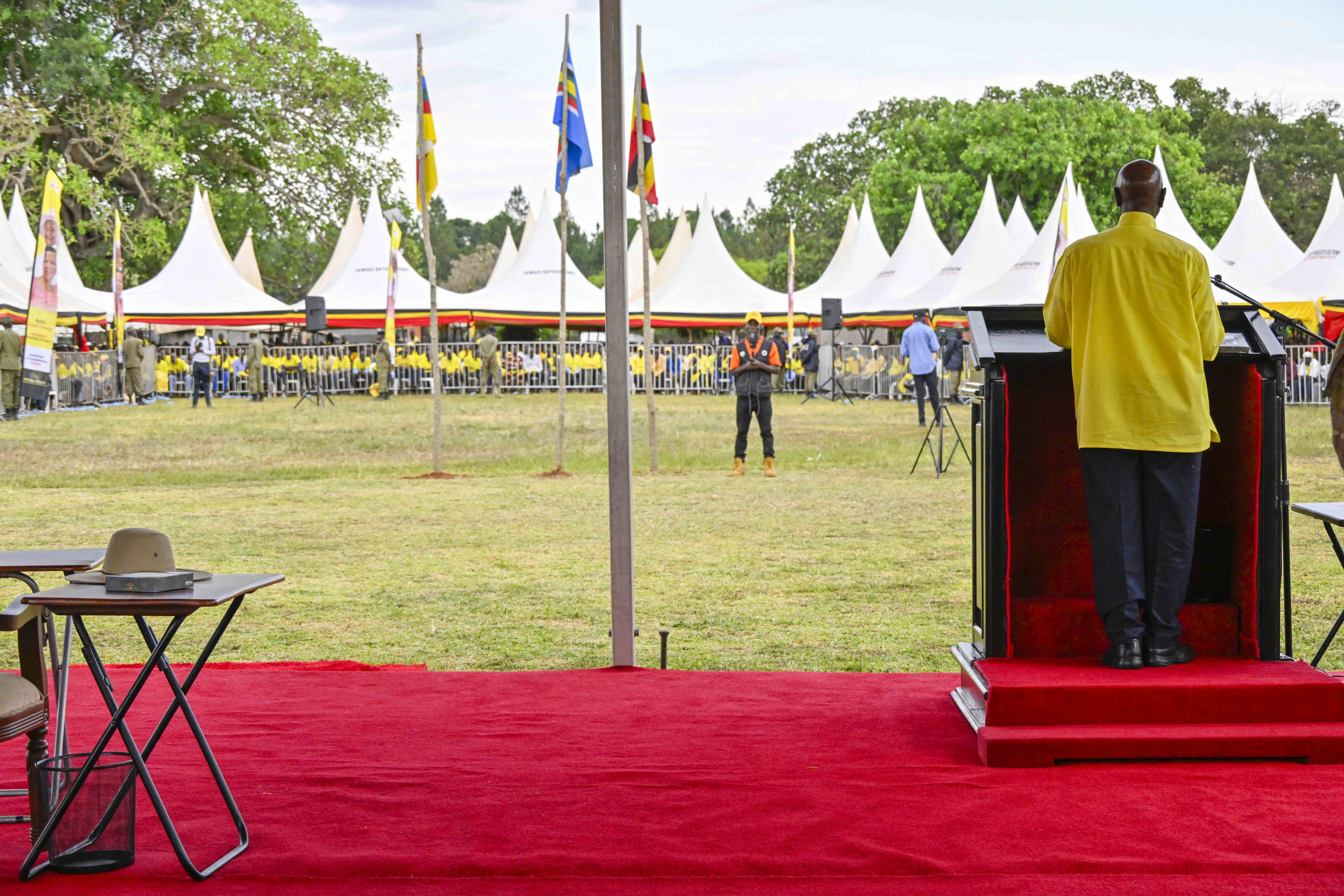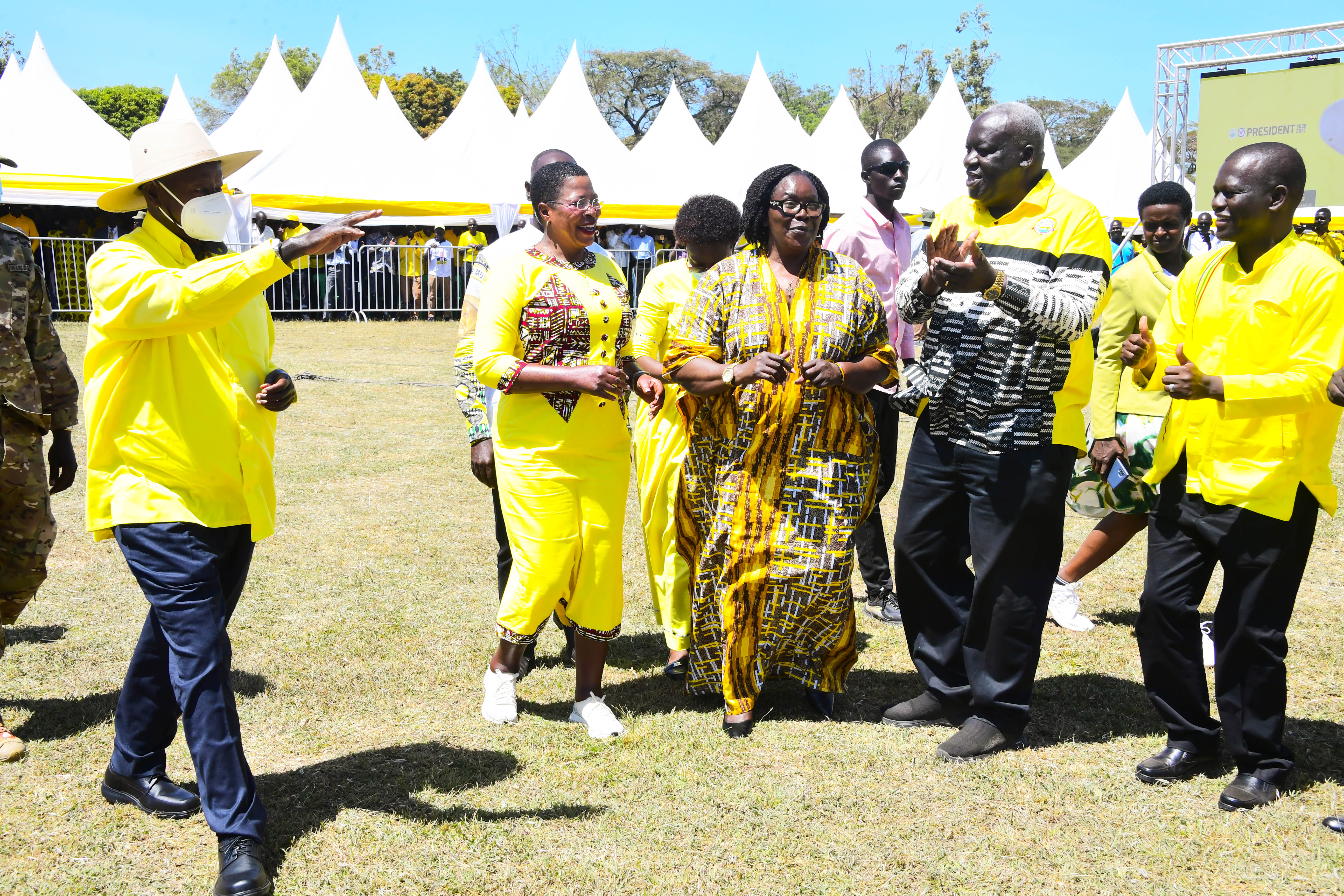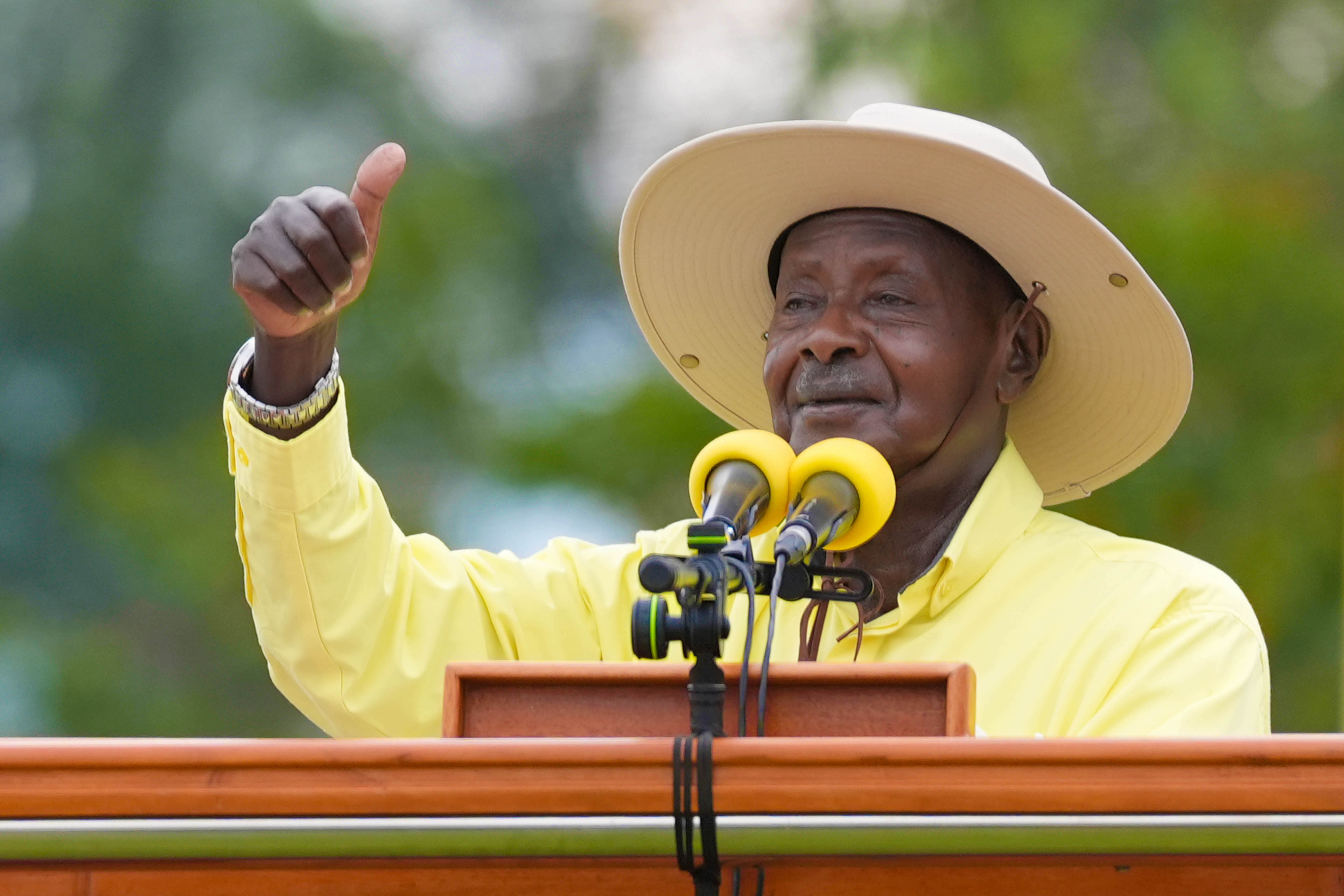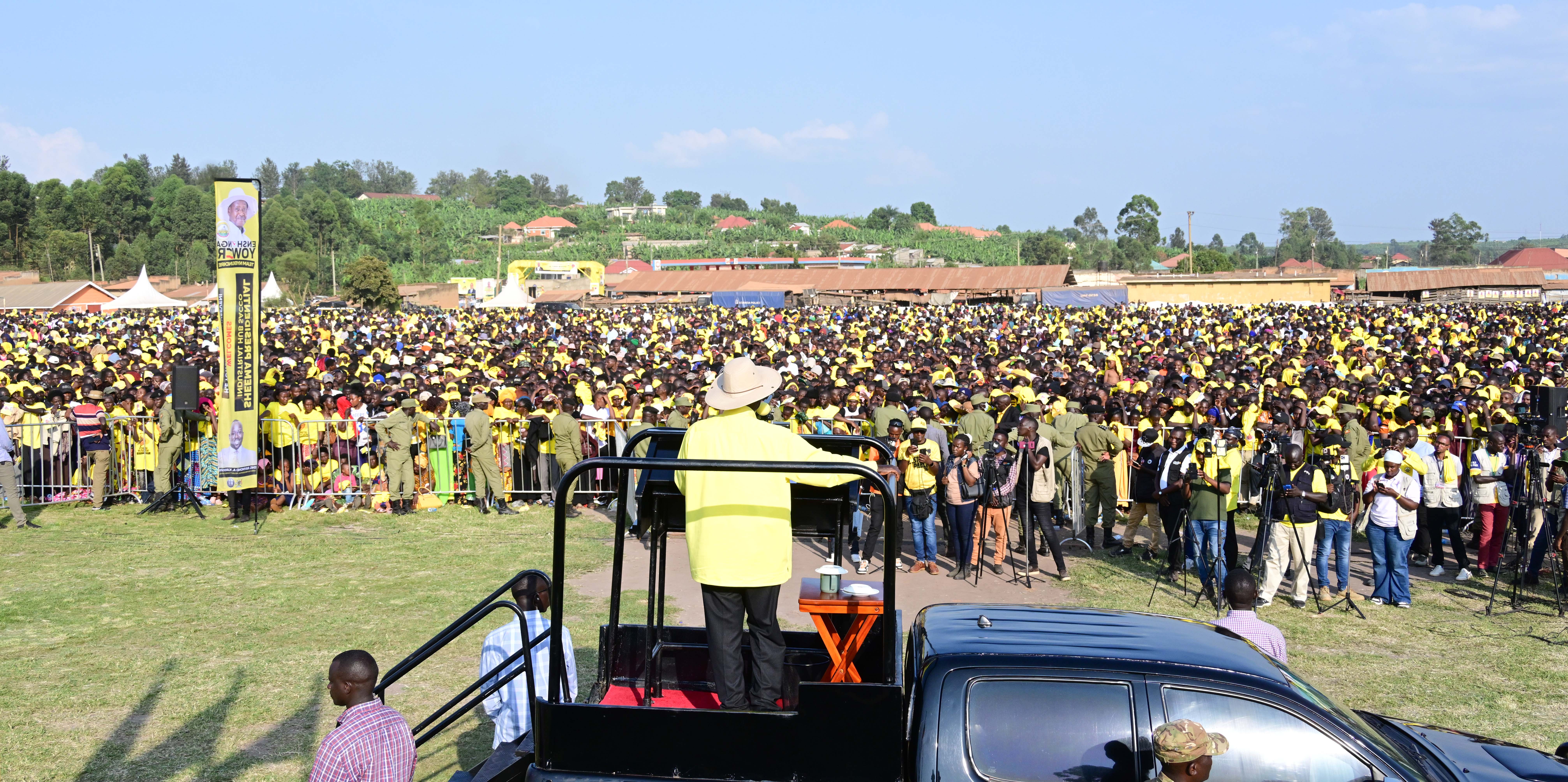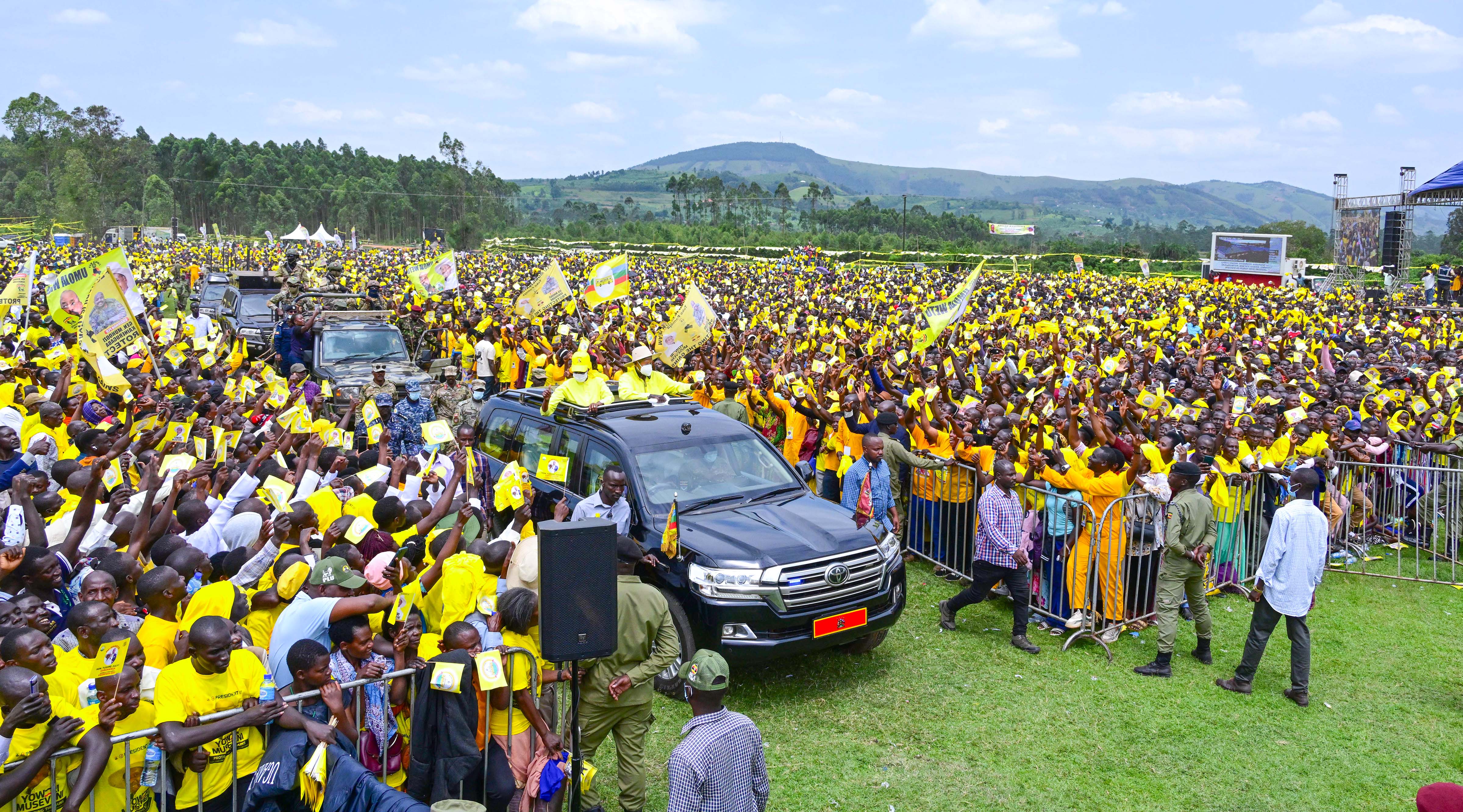06 December 2025
PRESIDENTIAL CANDIDATE MUNYAGWA’S FATHER THROWS WEIGHT BEHIND PRESIDENT MUSEVENI AHEAD OF 2026 ELECTIONS
Hajji Bruhan Sserunga, a veteran community leader and father of Hon. Mubarak Munyagwa, the presidential candidate for the Common Man’s Party, has publicly hailed President Yoweri Kaguta Museveni for his exceptional leadership, sending a strong message of respect and confidence ahead of the elections.
Speaking to thousands of President Museveni’s supporters during a campaign rally at Kayombo Primary School in Kitagwenda today, Mzee Sserunga declared, “I am a civilian veteran. I helped the NRA war people by offering shelter. I have seen where this country has come from and where it is going. I hail President Museveni for his good and wise leadership.”
He also praised the President’s vision for peace, development, and wealth creation, highlighting how the community has benefited from the government’s various development programs. Mzee Sserunga further requested the people of Kitagwenda to overwhelmingly vote for President Museveni for another term in office for more development.
President Museveni, visibly moved, commended Mzee Sserunga for his lifelong service to the nation, saying his counsel and support have been invaluable to the local communities.
“I thank God for enabling me to meet my veteran comrade Mzee Bruhan Sserunga, the father of Munyagwa, who understands the challenges of our fishing communities, I will engage him further,” he said.
On the other hand, President Museveni hailed Kitagwenda farmers for engaging into the money economy, something that he has emphasized since the 1960s.
“I thank the farmers in Kitagwenda. I have been informed that 60% of the homes are already engaged in the money economy, this is good news, it is something that we have been talking about since the 1960s, wealth creation at the household level is key for you as an individual,” he said.
The President highlighted the distinction between development and wealth, noting that while development benefits the entire community, wealth creation is an individual, family, or company-based endeavor.
“Many people confuse development and wealth. Development is for all, but wealth is personal. In Banyankole, when one is blessing another, they say, kazaare, katungye ente no tookye, they don’t say katungye tarmac,” he explained.
He emphasized that despite the presence of long-standing infrastructure, such as tarmac roads, some people remain poor.
“Yes, development is key, but wealth at a household level is something that shouldn’t be taken for granted,” President Museveni said.
On peace and security, the President expressed gratitude to the Local Defence Units (LDU) for supporting the army in defeating the ADF rebels.
“The people of Kitagwenda are neighbors to Congo; you are witnesses that without peace, people die, property is destroyed, and lives are ruined. The NRM has refused war,” he noted.
The President also pledged that the government is going to work on the Ibanda–Kagongo–Kabujogera–Kamwenge road.
“We have secured a loan for this project,” he said, adding that some infrastructural delays are due to prioritization, as the army often focuses first on security and equipment.
Turning to wealth creation, President Museveni praised individuals practicing practical farming. He highlighted Mr. George Matongo, a local farmer who transitioned from subsistence farming to earning income through modern commercial agriculture.
“If you don’t have income in your homes, you are causing problems for your family but also for your country because the government gets taxes from what you buy. When you have no money, you are not contributing to your family or your nation,” he stressed.
President Museveni also pledged to set up a coffee factory to support farmers in the district.
On job creation, the President said, “Government jobs are only 480,000. Factories alone have created 1.3 million jobs. I really feel sorry for Africa when people call themselves leaders by just talking. When you produce a good, who buys it? The internal market is not enough. That’s why the NRM says: let’s have Uganda unite maximally. When I produce milk in Mbarara, I am happy when the people of Arua buy it. We need a broader market, Uganda, East Africa, and Africa.”
President Museveni also highlighted success stories from the Presidential Skilling Hubs.
He shared the story of Ninsiima Moria from Kitagwenda District, who dropped out in Primary Three but later joined the Kyenjojo Presidential Skilling Hub.
“I studied hairdressing and mindset change for six months free of charge. Everything such as food, accommodation, and medicine was provided,” Ninsiima said.
“After training, I started my own salon and now I employ two workers. I also train students and earn an income every weekend. I have 20 hens and a coffee plantation.”
The President praised Ninsiima, noting that she is now skilled, a wealth creator, and an employer.
On her part, the Speaker of Parliament and Second National Vice Chairperson of the NRM, Hon. Anita Annet Among, hailed residents of Kitagwenda for their loyalty to the ruling party and commended them for warmly receiving the President during his visit to the district.
Rt. Hon. Among described Kitagwenda as a hard-to-reach area that has historically faced service delivery challenges but credited the President for granting the area district status, saying the move has laid a firm foundation for accelerated development.
She praised the President for his continued support to farmers, noting that Kitagwenda is predominantly a coffee-growing district whose farmers rely heavily on access to quality seedlings and sustained government backing to improve productivity and incomes.
The Speaker also commended the government for investing in water infrastructure, citing the Kanara Gravity Water System, which cost Shs375 million and is now serving more than 1,600 farmers, significantly easing access to clean water for both domestic use and agricultural activities.
On health services, Rt. Hon. Among backed the request raised by the district leadership, confirming that Ntara Health Centre IV will be upgraded to a district general hospital, a development she said will improve access to specialised healthcare and reduce referrals outside the district.
Regarding infrastructure, she informed residents that the Ibanda–Kagongo–Kabujogera–Kamwenge road has already been approved for construction, and assured them that works will commence soon.
Rt. Hon. Among reaffirmed President Museveni’s commitment to youth empowerment, describing him as a leader who consistently prioritises young people through targeted programs aimed at employment creation and wealth generation.
She concluded by urging unity within the NRM, stressing that party cohesion remains central to sustaining peace and accelerating development across communities.
The NRM Chairperson for Kitagwenda District, Mr. Nathan Masana lauded President Museveni for maintaining peace and rolling out government programs that are transforming livelihoods, particularly among the youth, women and the elderly.
Mr. Masana noted that Kitagwenda is a young district, having been carved out of Kamwenge in 2018 and beginning full operations in 2019.
Despite its youthful status, he said the district has registered steady progress anchored on stability and targeted government interventions.
He particularly appreciated the Emyooga programme and the Parish Development Model (PDM), which he said are steadily integrating households into the money economy.
Kitagwenda District, Mr. Masana reported, is administratively composed of 13 sub-counties and town councils, 55 parishes and 356 villages, with a population of 184,947 people, according to the 2024 National Population Census.
On wealth creation, he revealed that the district’s 55 parishes have cumulatively received Shs16.89 billion under the PDM, with 99.91 percent of the funds already disbursed to 16,875 beneficiary households.
Mr. Masana further informed the President that Kitagwenda has 18 Emyooga SACCOs with 12,543 members, which have so far received Shs960 million in government support.
In the education sector, he noted that the district has 68 government and 88 private primary schools, as well as seven government and 13 private secondary schools. Six government secondary schools offer Universal Secondary Education (USE) and Universal Post-O-Level Education and Training, with a combined enrollment of 32,703 learners.
However, he pointed out gaps in access, noting that 23 parishes still lack a government primary school, while seven out of the 13 sub-counties do not have a government secondary school.
Health service delivery, Mr. Masana said, remains a key challenge. Of the 13 sub-counties, only one has a Health Centre IV and four have Health Centre IIIs, leaving eight sub-counties without any health facility of that level.
He therefore appealed for the upgrade of Ntara HCIV to a general hospital and the elevation of several Health Centre IIs to Health Centre IIIs, alongside the construction of new Health Centre IIIs in Ntara Town Council, Kicheche, Ruhunga and Mahyoro sub-counties.
On water and sanitation, Mr. Masana reported that 62 percent of villages have access to safe water, leaving 37.9 percent still unserved.
He highlighted major achievements, including the rehabilitation and expansion of gravity flow schemes, construction of piped water systems serving thousands of residents, solar-powered water projects, drilling of boreholes and construction of public latrines.
He said government plans are underway to close the remaining gap through solar-powered mini water schemes, rehabilitation of existing sources, and targeted investments aimed at achieving universal safe water coverage within the next two years.
In agriculture, Mr. Masana cited successful solar-powered irrigation systems in Ntutu and Kyendangara sub-counties, which are boosting coffee production and generating millions of shillings in annual income for farmers.
On infrastructure, he welcomed the connection of Kitagwenda to the national electricity grid, noting that eight sub-counties are already connected, with the government pledging to extend power to the remaining sub-counties in the next term.
He further appealed for the construction of the Ibanda–Kagongo–Kabujogera–Kamwenge road, describing it as a vital link for trade, service delivery and regional integration.
Mr. Masana concluded by expressing gratitude to the President for peace and steady development, pledging continued support for the NRM and government programs aimed at transforming the lives of ordinary Ugandans.
The event was attended by NRM Central Executive Committee (CEC) members, Members of Parliament, religious and cultural leaders, as well as thousands of supporters.
